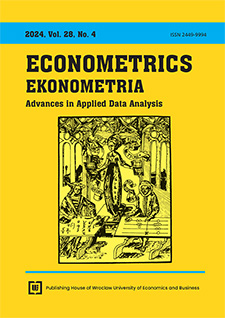Comparison of Machine Learning and Statistical Approaches of Detecting Anomalies Using a Simulation Study
DOI:
https://doi.org/10.15611/eada.2024.4.02Keywords:
anomaly detection, simulation study, machine learningAbstract
Aim: An anomaly is an observation or a group of observations that is unusual for a given dataset. Anomaly detection has many applications, not only as a step of data preparation but also, for example, as a way of identifying credit card fraud detection, network intrusions and much more. There are diverse methods of anomaly detection. In particular two groups of methods have been developed independently – statistical methods and machine learning algorithms. Those methods are rarely compared. While statistical methods focus on formulating a measure of the abnormality of the observations, supervised machine learning makes it possible to use data about typical observations and previously identified anomalies. The aim of this paper was to compare the two approaches by conducting a simulation study.
Methodology: A simulation study was conducted, during which the data was generated using copula functions. For the purpose of generating different types of anomalies, marginal distributions of the variables were manipulated. The effectiveness of each method was evaluated based on measures of classification model performance.
Results: While the accuracy of the statistical methods was dependent on the precise prediction of the percentage of the anomalies that would occur in the data, the machine learning algorithms’ recall was significantly lower when the change in the marginal distribution of the value parameters was smaller.
Implications and recommendations: For the statistical methods included in the study, knowledge about the distribution of the variables was crucial while the supervised machine learning algorithms required acquiring a training dataset. Unlike machine learning algorithms, the statistical methods performed with similar accuracy even when the change in the marginal distribution parameters’ value was smaller.
Originality/value: The two approaches to anomaly detection presented in the paper are not often compared, usually used by two separate groups of researchers – statisticians and machine learning or data science specialists.
Downloads
References
Aggarwal, C. C. (2017). Outlier Analysis (2nd ed. 2017). Springer International Publishing. https://doi.org/10.1007/978-3-31947578-3
Baron, D., & Poznanski, D. (2017). The Weirdest SDSS Galaxies: Results from an Outlier Detection Algorithm. Monthly Notices of the Royal Astronomical Society, 465(4), 4530-4555.
Belsley, D. A., Kuh, E., & Welsch, R. E. (1980). Regression Diagnostics: Identifying Influential Data and Sources of Collinearity. John Wiley & Sons.
Breiman, L. (2001). Random Forests. Machine Learning, 45, 5-32.
Chandola, V., Banerjee, A., & Kumar, V. (2009). Anomaly Detection: A Survey. ACM Computing Surveys (CSUR), 41(3), 1-58.
Das, S., Dey, A., Pal, A., & Roy, N. (2015). Applications of Artificial Intelligence in Machine Learning: Review and Prospect. International Journal of Computer Applications, 115(9), 31-41.
Faaique, M. (2024). Overview of Big Data Analytics in Modern Astronomy. International Journal of Mathematics, Statistics, and Computer Science, 2, 96-113.
Green, R. F. (1976). Outlier-prone and Outlier-resistant Distributions. Journal of the American Statistical Association, 71(354), 502-505.
Hawkins, D. M. (1980). Identification of Outliers (Vol. 11). Springer.
Hofert, M., Kojadinovic, I., Maechler, M., & Yan, J. (2024). copula: Multivariate Dependence with Copulas. R package version 1.1-4. https://CRAN.R-project.org/package=copula
Jabez, J., & Muthukumar, B. (2015). Intrusion Detection System (IDS): Anomaly Detection Using Outlier Detection Approach. Procedia Computer Science, 48, 338-346.
Kulkarni, A., Mani, P., & Domeniconi, C. (2017). Network-based Anomaly Detection for Insider Trading. arXiv Preprint arXiv:1702.05809.
Lee, L.-F. (1983). Generalized Econometric Models with Selectivity. Econometrica: Journal of the Econometric Society, 51(2), 507-512.
Liu, J., Xie, G., Wang, J., Li, S., Wang, C., Zheng, F., & Jin, Y. (2024). Deep Industrial Image Anomaly Detection: A Survey.
Machine Intelligence Research, 21(1), 104-135.
Maddireddy, B. R. (2024). Neural Network Architectures in Cybersecurity: Optimizing Anomaly Detection and Prevention. International Journal of Advanced Engineering Technologies and Innovations, 1(2), 238-266.
Mehrotra, K. G., Mohan, C. K., & Huang, H. (2017). Anomaly Detection Principles and Algorithms. Springer International Publishing. https://doi.org/10.1007/978-3-319-67526-8
Nelsen, R. B. (1998). An Introduction to Copulas. Springer science & business media.
Prarthana, T. S., & Gangadhar, N. D. (2017). User Behaviour Anomaly Detection in Multidimensional Data. 2017 IEEE International Conference on Cloud Computing in Emerging Markets (CCEM), 3-10.
Serrano-Cinca, C., Gutiérrez-Nieto, B., & Bernate-Valbuena, M. (2019). The Use of Accounting Anomalies Indicators to Predict Business Failure. European Management Journal, 37(3), 353-375.
Sklar, M. (1959). Fonctions de répartition à n dimensions et leurs marges. Annales de l’ISUP, 8(3), 229-231.
Thimonier, H., Popineau, F., Rimmel, A., Doan, B. L., & Daniel, F. (2024, February). Comparative Evaluation of Anomaly Communication Technology (pp. 37-50). Detection Methods for Fraud Detection in Online Credit Card Payments. In International Congress on Information and
Yan, J. (2007). Enjoy the Joy of Copulas: With a Package copula. Journal of Statistical Software, 21(4), 1-21. https://doi.org/10.18637/jss.v021.i04
Downloads
Published
License
Copyright (c) 2025 Klaudia Lenart

This work is licensed under a Creative Commons Attribution-ShareAlike 4.0 International License.
Accepted 2024-12-16
Published 2025-02-27









